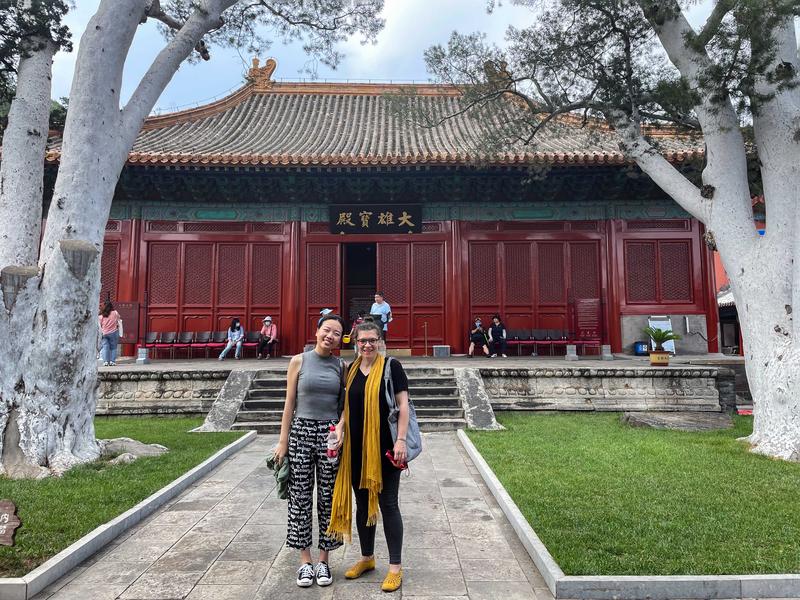Hornemann Institute Publishes Technical Terms for Conservation/Restoration in Chinese for the First Time
The EwaGlos of the Hornemann Institute of the HAWK receives its 16th language version
The European Illustrated Glossary of Conservation Terms for Wall Paintings and Architectural Surfaces is now published in Mandarin: The translation, which Gesa Schwantes, Associate Professor at the Institute for the Conservation of Cultural Heritage at Shanghai University in China, developed together with a team of Chinese colleagues, has been available free of charge since November 2022 on the website of the Hornemann Institute of the HAWK University of Applied Sciences and Arts Hildesheim/Holzminden/Göttingen.
EwaGlos includes the English definitions of important technical terms developed inan EU project as well as their translations into the native languages of the partners, i.e. Bulgarian, Croatian, French, German, Hungarian, Italian, Polish, Spanish and Turkish.
The German conservator Gesa Schwantes, who led the Chinese translation project, had already used the English version of EwaGlos, published in 2015, for her teaching at the University of Hong Kong. There, between 2011 and 2020, she set up and ran a laboratory for art technology and conservation at the Faculty of Architecture and also taught the students of the Architectural Conservation Programme (MSc and BA Conservation) the basics of conservation technology and conservation science. She found the paraphrased terms very useful: "So far, I have only given my students the PDF file with the English explanations. But from the very first time, I thought it would be great to have a Chinese version," she explains. After she took up her new position as Associate Professor at the Institute for the Conservation of Cultural Heritage at Shanghai University in January 2021, the issue of finding good bilingual teaching materials, or developing them, became even more central. The students at Shanghai University in the field of conservation are not used to taking courses in English and the correct teaching of technical terms was therefore even more complicated.
"When she contacted us and offered to do this important translation, she started with the idea of adding a few more terms to the original 200 selected. Our EU consortium had a tough time on the limitation and selection of these terms, because there is always something missing, you never get the whole range, especially as Chinese mural painting and art technology is very complex," adds Dr Angela Weyer, head of the Hornemann Institute at the HAWK in Hildesheim.
From 2013 to 2015, Angela Weyer coordinated the EU project, which initially published the 200 technical terms of the glossary in 11 languages in 2015 and in 2016 – after an international evaluation – made a revised version available on the internet. The subsequent translations into Arabic (June 2017), Japanese (July 2018), Russian (December 2018) and Persian (May 2019) are based on this second, improved edition. All translations of the EwaGlos can also be downloaded for free from the Hornemann Institute's website.
Gesa Schwantes decided to stick with the terms initially selected for EwaGlos, but added her German mother tongue, so the Chinese translation she has now published includes the German definitions as well as the English ones.
She carefully selected her team: a former, exceptionally good Master's student of conservation technology, who at the time was a PhD candidate at Nicolaus Copernicus University in Toruń in Poland but could not enter there because of Covid, as well as a conservator from the cultural heritage conservation department of the government of Shanxi province. Gesa Schwantes worked through their comments and questions on the first translation. Since a 1:1 translation is almost impossible, she consulted other colleagues for some translation problems. She then sent the different chapters to colleagues with very good English skills. "One of these editors pointed out to her, that some terms are used differently in China, a phenomenon that we also have here, in Germany," explains Angela Weyer.
"Despite these limitations, my colleagues find this publication very helpful," Gesa Schwantes sums up today, after about 100 days of its internet publication. "Its extensive bibliography will certainly help to make English specialised literature more accessible to Chinese students. I myself have gained experience in the process, which I hope to use in the future to compile a textbook on Chinese traditional mural paintings, its techniques, materials and historic restoration measures in English and Chinese. That would be great."
Caption:
IMG_0731
German conservator Gesa Schwantes with her former student Zou Luli, who did a great deal of the translation work for the Chinese version of the EwaGlos. (Photo: Gesa Schwantes)
Wissenschaftlicher Ansprechpartner:
Dr. Angela Weyer
Head of Hornemann Institute
E-Mail: weyer@hornemann-institut.de
Tel: +49/5121/408-179
Kesslerstr. 57 (Room HIJ_)
31134 Hildesheim, NI
Germany
Originalpublikation:
EwaGlos - European Illustrated Glossary of Conservation Terms for Wall Paintings and Architectural Surfaces Chinese Translation of the English and German Terms
Hildesheim 2022, Germany
ISBN: 978-3-7319-0260-7
https://doi.org/10.5165/hawk/505
Weitere Informationen:
https://hornemann-institut.de/en/epubl_ausgabe_detail.php?id=259&case=1&from=
https://hornemann-institut.hawk.de/en/projects/research/ewaglos
Die semantisch ähnlichsten Pressemitteilungen im idw



